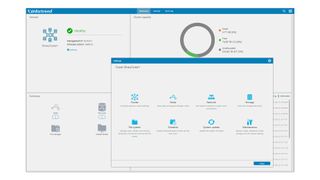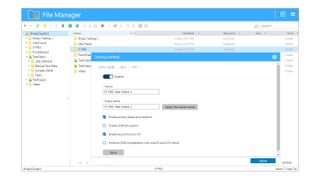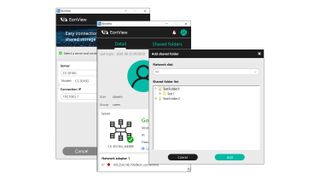IT Pro Verdict
Pros
- +
Easy deployment
- +
Great value
- +
Huge cluster expansion potential
- +
Extensive data port options
- +
Open drive policy
Cons
- -
Monitoring needs to be more informative
Infortrend has a well-established reputation for delivering enterprise storage solutions at more sensible prices than the blue chips, and its CS Series of appliances signals its first foray into the scale-out NAS arena. This extended family offers plenty of storage options; you can choose from 16, 24 or 60-bay LFF models with 3U or 4U form factors plus a 2U 25-bay SFF version and plump for single or dual controllers.
On review, we have the CS 3016G which gets you started with a single controller and 16 hot-swap drive bays supporting SAS and SATA drives. As a member of the ‘G’ series, this model is not upgradeable to dual controllers but those with the ‘D’ designation are, and will provide fully transparent failover.
Infortrend favours Intel’s 2.2GHz Intel Xeon D2123IT CPU as the driving force behind many of its storage appliances. Along with this CPU, the CS 3016G controller comes with 64GB of battery backup unit (BBU) protected DDR4 cache memory upgradeable to 256GB.
Port choices abound - the controller offers quad 10GbE SFP+ ports and two expansion slots which support optional 10GbE, 25GbE and 40GbE host boards. The appliance can scale up as well as scale out as its dual SAS3 ports can be used with Infortrend’s disk shelves to take the drive count up to 76.
Infortrend EonStor CS 3016G review: Scaling
You can start with a single appliance running in a simple ‘distributed’ mode and to unleash Infortrend’s clustering, erasure coding and replica technologies, you’ll need a minimum of three. We were supplied with three appliances, which we kitted out with 48 of Toshiba’s latest enterprise-class 16TB MG08ACA16TE SATA drives - unlike many competitors, Infortrend operates an open drive policy so you can choose your own.

Clusters require two network ports on each appliance, or node, to link all members together and we cabled two 10GbE ports on each one to a dedicated Netgear 10GbE switch. The remaining ports are used as the front-end to present storage to hosts and we connected the other two 10GbE ports on each node to a Dell EMC S5148F-ON 25GbE switch.
Infortrend claims a 30 minute installation and if you take out the hardware setup, this is quite achievable. You designate one node as the master by pressing the mute/service button on its rack ear until the service LED flashes white.
Now it’s over to the EonOne web console and its quick start wizard which displays all connected nodes, helps set up the front-end ports and offers the choice of RAID5, RAID5 with a hot spare in each node and RAID6. We opted for RAID5 and the initial setup process was completed in 15 minutes.
The cluster is ready for action at this stage, but we needed to wait until it had completed RAID initialization before running our performance tests. Annoyingly, the EonOne node status page doesn’t currently show its progress so we had to twiddle our thumbs for nearly two days until all the drive activity LEDs had stopped flashing.
Infortrend EonStor CS 3016G review: Storage features
For storage configuration, you create disk pools within the cluster, enter a size in TB and decide whether they use erasure coding or are a replica if you want multiple copies. For erasure coding, our setup supported a 2+1 protection level where the first number is the minimum number of nodes for a functional cluster while the second is the number that can be lost for it to stay operational.

A cluster supports up to 144 nodes and as you add more, the levels of erasure coding protection increase so for a 10 node cluster, you can opt for the maximum 8+2 protection. Cluster self-healing comes into play if a node or pool fails. It goes into a degraded state and if it doesn’t come back online within a time period of between 5 minutes and one hour (your choice), it automatically writes data from the failed unit to the active nodes.
Along with SEDs (self-encrypting drives), Infortrend supports WORM (write once, ready many). During pool creation, you set a retention period in years during which time all files in the pool cannot be deleted and set a wait period in hours after which newly created files become read-only.
Share management is handled by a separate File Manager web portal which can be loaded directly from the EonOne console. To create a shared folder, you choose a storage pool, enter a size, add a quota, set local or Active Directory user and group permissions and enable CIFS/SMB, NFS and FTP as required.
Infortrend EonStor CS 3016G review: Performance
The cluster presents two channels for all the front-end ports and each node provides an IP address for each one which can be used to create high bandwidth trunks. Clients can gain access to shared folders from any of these addresses and use port aggregation for link fault tolerance.
Performance over 10GbE is on a par with other high-end NAS appliances as Iometer reported raw sequential read and write rates of 9.3Gbits/sec and 9Gbits/sec for a mapped share. Real world speeds are up there too, and our 25GB file copy returned read and write averages of 5.3Gbits/sec and 4.8Gbits/sec, while a backup test using a 22.4GB folder with 10,500 small files returned a creditable 2.6Gbits/sec.

The EonView desktop utility helps map shares to workstations as it searches for cluster front-end ports and displays shares available to the logged in user. Just select a share and drive letter and it does the rest - plus, it can link up with the native Windows or macOS backup app for further data protection and restore facilities.
Infortrend EonStor CS 3016G review: Verdict
Infortrend’s EonStor CS 3016G offers a simple, easily deployed NAS scale-out solution and its affordable price tag makes it very appealing to a wide range of businesses. The web console monitoring features need some improvements but otherwise, we were impressed with how easy it is to configure and with a single cluster supporting up to 144 nodes, it delivers an amazing expansion potential.
Infortrend EonStor CS 3016G specifications
| Chassis | 3U rack |
| Storage | 16 x SAS/SATA LFF/SFF hot-swap drive bays |
| Power | 2 x 530W hot-plug PSUs with cooling fans |
| Controllers | Single controller with the following: |
| CPU | 2.2GHz 4-core Intel Xeon D-2123IT |
| Memory | 64GB DDR4 cache (max 256GB) with BBU |
| Array support | RAID 5, 5 + hot-spare, 6 |
| Host interfaces | 4 x 10GbE SFP+, 2 x host board slots |
| Network | Gigabit management port |
| Protocol support | CIFS/SMB, NFS, FTP, Rsync |
| Expansion | Up to 144 nodes, max 76 drives per node |
| Management | EonOne, File Manager, EonView |
| Warranty | 3 year limited |
Dave is an IT consultant and freelance journalist specialising in hands-on reviews of computer networking products covering all market sectors from small businesses to enterprises. Founder of Binary Testing Ltd – the UK’s premier independent network testing laboratory - Dave has over 45 years of experience in the IT industry.
Dave has produced many thousands of in-depth business networking product reviews from his lab which have been reproduced globally. Writing for ITPro and its sister title, PC Pro, he covers all areas of business IT infrastructure, including servers, storage, network security, data protection, cloud, infrastructure and services.



